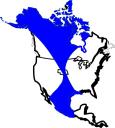Puddle ducks, also called dabbling ducks, are the largest and most widespread group of waterfowl in the world! They include the wild ducks most familiar to people. The two major duck groups, puddle and diving ducks, differ in several ways.
Divers inhabit large deep lakes and rivers, and coastal bays and inlets; puddle ducks tend to stick to the shallows of lakes, rivers and freshwater marshes, although they frequent saltwater, especially during migration. Diving ducks are, as their name implies, adept at diving and obtain most of their food this way. Puddle ducks, such as mallards and gadwall, prefer to feed on the surface or close to it; often they stretch their heads underwater, feeding upended with their tails in the air. As a group, they are not accomplished divers, but adults dive occasionally and ducklings do so frequently.
Puddle ducks feed in the water along the fringes of islands and shorelines and on dry land. Their diet consists mainly of vegetable matter: seeds, grasses, leaves and stems of underwater plants, agricultural crops, nuts, along with mollusks, insects and fish.
These shallow-water ducks ride higher in the water than their diving cousins, and launch themselves directly upward when taking off; they do not need to run across the water to build up speed for takeoff as diving ducks do. Puddle ducks are excellent swimmers, sure-footed on land, and swift agile fliers. On the wing, they often display a speculum, or wing patch – a bright, iridescent panel of feathering close to the body on the trailing edge of each wing. Speculum color varies from species to species and may function as a flashing signal to help keep a flock together. To the human observer, the speculum is often a telltale field mark.
Within the species, males (called drakes) have bright, colorful plumage, while the females (hens) are drab. In fall, winter and spring, drakes are feathered in their normal bright coloration; in early summer, after breeding season, they molt into a drab “eclipse” plumage and resemble the hens for several months.
North American puddle ducks breed across the northern part of the continent; some species — mallards, black and wood ducks — nesting in Pennsylvania. They generally mate for the first time when a year old. During courtship, drakes chase the hens and engage in fighting, ritualized movements, posturing and calling. After mating, the drake leaves immediately, or he stays with the hen while she is laying and then departs soon afterward. Pair bonds are weak, and a different mate will be courted each year. The hen lays a large clutch of eggs (7-13, depending on the species) in a nest built of grasses, leaves and reeds, hidden among vegetation. She incubates and cares for the brood by herself.
Ducklings are covered with down; they are a pale brownish color, streaked with darker lines to disguise their body outlines. Minutes after hatching, they can swim and feed themselves. They first fly at about two months of age.
In autumn puddle ducks fly south, along with diving ducks and geese. Waterfowl start migrating through the Central Flyway in late August; the movement peaks in October and ends in December. Some puddle ducks occasionally winter in the northern states, but most spend the cold months along the gulf coast of the flyway.
Raccoons, foxes, minks, hawks and owls prey upon ducks. Raccoons, skunks and crows eat the eggs; snapping turtles and fish take the young.
Taxonomists group puddle ducks in family Anatidae, subfamily Anatinae. The Anatinae form the largest and most diverse of the commonly recognized waterfowl subfamilies, with more than 40 species worldwide. Pennsylvania puddle ducks all belong to genus Anas.

